
Thanjavur painting is a classical South Indian painting style, originating in the town of Thanjavur in Tamil Nadu. The art form draws its immediate resources and inspiration from way back about 1600 AD, a period when the Nayakas of Thanjavur under the suzerainty of the Vijayanagara Rayas encouraged art—chiefly, classical dance and music—as well as literature, both in Telugu and Tamil and painting of chiefly Hindu religious subjects in temples. It is distinguished by its famous gold coating. However, it can safely be surmised that Thanjavur painting, as we know it now, originated in the Maratha court of Thanjavur (1676–1855). It has been recognized as a Geographical indication by the Government of India in 2007–08.

Shahu of the Bhonsle dynasty of Marathas was a Raja and the first Maharaja (1900–1922) of the Indian princely state of Kolhapur. Rajarshi Shahu was considered a true democrat and social reformer. Shahu Maharaj was an able ruler who was associated with many progressive policies during his rule. From his coronation in 1894 till his demise in 1922, he worked for the cause of the lower caste subjects in his state. Primary education to all regardless of caste and creed was one of his most significant priorities.

Saraswathi Mahal Library, also called Thanjavur Maharaja Serfoji's Saraswathi Mahal Library is a library located in Thanjavur (Tanjore), Tamil Nadu, India. It is one of the oldest libraries in Asia established during 16th century by Nayakar kings of Thanjavur and has on display a rare collection of Palm leaf manuscripts and paper written in Tamil and Sanskrit and a few other indigenous languages of india. The collection comprises well over 49,000 volumes, though only a tiny fraction of these are on display. The library has a complete catalog of holdings, which is being made available online. Some rare holdings can be viewed on site by prior arrangement. Encyclopedia Britannica mentions the library as the "Most remarkable library of India".

Serfoji II Bhonsle also spelt as Sarabhoji II Bhonsle, was the last ruler of the Bhonsle dynasty of the Maratha principality of Tanjore to exercise absolute sovereignty over his dominions. His descendants, however, have managed to thrive as titular Maharajahs of Thanjavur to the present day. Serfoji belonged to the Bhonsle clan of Marathas and was descended from Chhatrapati Shivaji Maharaj's half-brother Venkoji. He ruled Thanjavur from 1798 until his death in 1832.

The Thanjavur Nayakdynasty were the rulers of Thanjavur in the 15th and 17th centuries. The Nayaks, who belonged to the Telugu-speaking Balija social group were originally appointed as provincial governors by the Vijayanagara Emperor in the 15th century, who divided the territory into Nayak kingdoms which were Madurai, Tanjore, Gingee and Kalahasthi. In the mid-15th century they became an independent kingdom, although they continued their alliance with the Vijayanagara Empire. The Thanjavur Nayaks were notable for their patronage of literature and the arts.

Thanjavur Marathi people, are a Thanjavur Marathi-speaking ethno-linguistic group, who reside in the central and northern parts of the Indian state of Tamil Nadu. They are the descendants of Marathi administrators, soldiers and noblemen who migrated to this region during the rule of the Thanjavur Maratha kingdom. Thanjavur was a Maratha kingdom in Tamil Country, until the British East India Company dethroned the last Thanjavur Maratha king, Shivaji of Thanjavur. It was founded by Maratha Warrior King Chatrapati Shivaji's half-brother, Ekoji alias Venkoji Rajē Bhonsalē. The Kshatriyas use Maratha, while the Brahmins use the surname Deshastha.
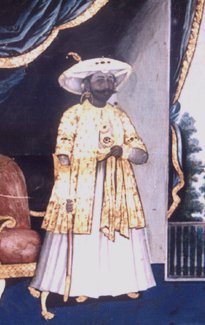
Raja Shivaji of the Bhonsle dynasty of Thanjavur in India, was the son of Raja Serfoji II and ruled the fortress of Thanjavur and its surroundings from 1832 to 1855. He was the last Raja of Thanjavur known to wield any authority.
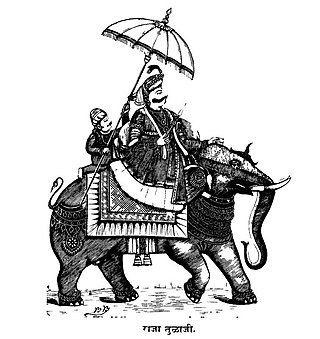
Thuljaji Bhonsle (1738–1787) was the eldest son of Pratap singh and the ruler of Thanjavur Bhonsle dynasty from 1763 to 1773 and 1776 to 1787. He was a weak-hearted ruler despite being extremely generous. His period is known for the treaties which made Thanjavur subordinate to the British East India Company.
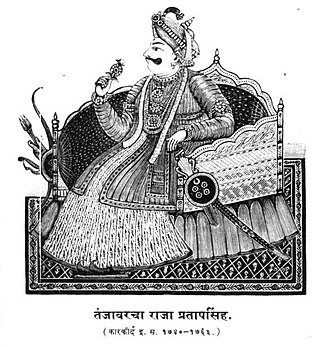
Pratap Singh Bhonsle or Pratapsinha was the Maratha ruler of Thanjavur of the Bhonsle dynasty from 1739 to 1763. His rise to power followed three years of anarchy and civil war and restored the state to its previous greatness. His reign witnessed the Carnatic Wars and the Seven Years' War.
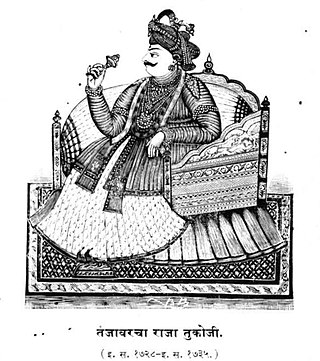
Tukkoji Bhonsle (1677–1736) was the fourth Maratha ruler of Thanjavur, located in South India. He was from the Bhonsle dynasty and was the son of Ekoji I as well as the younger brother of Shahuji I and Serfoji I. Tukkoji ruled Thanjavur from 1728 to 1736.

Serfoji I Bhonsle (1675–1728), also spelt as Sarabhoji I Bhonsle, was the son of the Maratha ruler of Thanjavur Ekoji I and the Raja of Thanjavur from 1712 to 1728. He was the third Raja of the Bhonsle dynasty of Thanjavur. He consolidated the hold of Marathas over Thanjavur and patronised arts and literature.
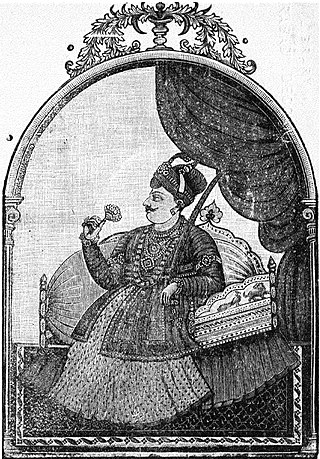
Shahuji I Bhonsle (b.1672) also called Shahji of the Bhonsle dynasty was the second Maratha ruler of Thanjavur. He was the eldest son of Ekoji I, who was a half brother of Shivaji, the first Maratha ruler of Thanjavur. He reigned from 1684 to 1712.
Ekoji II Bhonsle aka Venkoji II or Vyankoji II of the Bhonsle dynasty was the eldest surviving son of Maratha king of Thanjavur Tukkoji who succeeded to the throne on the death of his father in 1736. His reign was remarkably short and he died due to ill-health in 1737.

Vyankojirajah Bhonsle or Ekojirajah I Bhonsle was the younger half-brother of Shivaji and founder of Maratha rule in Thanjavur in modern day Tamil Nadu. He was the progenitor of the junior branch of the Bhonsle family which ruled Thanjavur until the formal annexation of the kingdom by the British East India Company in 1855.
Shahuji II Bhonsle of Katturaja of the Bhonsle dynasty was the name of the ruler of Thanjavur from 1738 to 1739 who rose to power based on the unverified claim of being an illegitimate son of Serfoji I.

The Thanjavur Maratha kingdom ruled by the Bhonsle dynasty was a principality of Tamil Nadu between the 17th and 19th centuries. Their native language was Thanjavur Marathi. Venkoji was the founder of the dynasty.
Vijaya Raghunatha Raya Tondaiman I was the second independent ruler of the Pudukkottai kingdom. He reigned from April 1730 to 28 December 1769. His reign was marked with incessant wars with the Thanjavur Maratha kingdom and against the French East India Company and Chanda Sahib.
The Marava War of Succession was the war of succession between, Vijayaraghunatha Sethupathi the heir apparent and eldest son of Raghunatha Kilavan and Tanda Thevar for the throne of Ramnad kingdom, also known as the Maravar Kingdom. The war of succession and the ensuing civil war lasted from 1720 to 1729 and resulted in the partitioning of the Ramnad kingdom reducing its power and influence.
Tryambaka-yajvan (1665-1750), also known as Tryambaka-raya-makhin, was a Hindu pandit and a minister at the court of the Thanjavur Maratha kings Shahaji I and Serfoji I. He is best known for writing Strī-dharma-paddhati - a treatise that describes the duties of the ideal Hindu woman from an orthodox point of view, and Dharmākūta - a commentary on Ramayana.

The Nizam's Carnatic campaigns (1725–27) were a series of military campaigns of the Nizam of Hyderabad against the Maratha Empire and the Thanjavur Maratha Kingdom. These campaigns were sparked by the Maratha's attempts to collect taxes from the Nizam's dominions in Carnatic, leading to a conflict over control and revenue.














